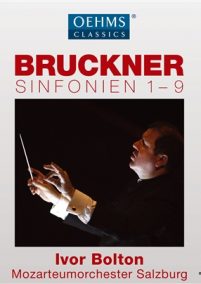
Mozarteumorchester Salzburg
Ivor Bolton, conductor
Alongside those with Simone Young and Stanislaw Skrowaczewski, OehmsClassics is now offering the third Bruckner cycle here with Ivor Bolton. This time it includes “only” the Symphonies Nos. 1 to 9. In its April 2017 issue, the renowned Gramophone Magazine wrote the following about the Second Symphony: “The overall impression is one of vividness and transparency, aided by the exemplary recording […] Among single-disc offerings of the 1872 edition, Bolton’s r ecording is hard to beat.”

Frankfurter Opern- und Museumsorchester
Ivor Bolton, conductor
Paula Murrihy, Orontea
Sebastian Geyer, Creonte
Juanita Lascarro Tibrino, Amore
Guy de Mey, Aristea
Xavier Sabata, Alidoro
Simon Bailey, Gelone
Matthias Rexroth, Corindo
Louise Alder, Silandra
Kateryna Kasper, Giacinta
Katharina Magiera, Filosofia
The premier of L’Orontea took place in 1656 in Innsbruck at the court of Archduke Ferdinand Karl, grandson of Duke Ferdinand of Tuscany, who at that time was the patron of the first attempts of the art form of opera in Florence.
Alongside Francesco Cavalli’s opera La Giasone, L’Orontea went down in history as the most successful opera of the late 17th century.

Mozarteumorchester Salzburg
Ivor Bolton, conductor
There are at least four versions of Anton Bruckner’s 2nd Symphony; the last one was written in 1892. Frequently, however – as on this CD recor-ding – the original version is preferred; as usual with Bruckner, this ver-sion of 1872 is bolder and longer.
Already very early on, the composer changed the order of movements in this work, which was felt by many to be a response to the drama-turgy of Beethoven’s Ninth Symphony.
The Scherzo, as the second movement, has changed places with the ensuing Adagio. In the later version, he also almost completely elimi-nated the most striking characteristic of this creation, probably due to the urging of his friends and supporters, especially Johann Herbeck: eight of the nine famous tutti rests in the first movement disappear completely.
Another special characteristic of the original version is the solo horn passage in the Adagio, written in an extremely difficult register for the instruments of that time – but also of moving beauty.
